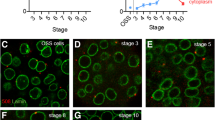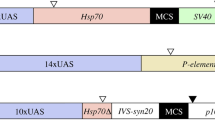Summary
spätzle (spz), a maternal effect gene of Drosophila, is involved in the establishment of the dorso-ventral axis during embryogenesis. Eggs from females lacking the spz gene product develop into completely dorsalized embryos, i.e. the ventral and lateral pattern elements fail to develop. Upon injection of either cytoplasm or poly(A)+ RNA from early wild-type embryos, spz embryos develop lateral pattern elements represented by Filzkörper and in the case of injected cytoplasm additional ventral pattern elements represented by ventral setae. Wild-type cytoplasm retains the rescuing activity longer than the poly(A)+ RNA fraction does, and cytoplasm is always more effective in provoking the rescue than poly(A)+ RNA. Mosaic females containing spz germ cells surrounded by spz + tissues were generated by pole cell transplantations; a mutant genotype in the germ cells is sufficient to produce all aspects of the spz mutant phenotype, suggesting that the maternal source of spz gene product is the germ line.
Similar content being viewed by others
References
Anderson KV, Nüsslein-Volhard C (1984) Information for the dorsal-ventral pattern of the Drosophila embryo is stored as maternal mRNA. Nature (Lond) 311:223–227
Anderson KV, Bokla L, Nüsslein-Volhard C (1985a) Establishment of dorsal-ventral polarity in the Drosophila embryo: the induction of polarity by the Toll gene product. Cell 42:791–798
Anderson KV, Jürgens G, Nüsslein-Volhard C (1985b) The establishment of dorsal-ventral polarity in the Drosophila embryo: genetic studies on the role of the Toll gene product. Cell 42:779–789
Lohs-Schardin M, Cremer C, Nüsslein-Volhard C (1979) A fate map for the làrval epidermis of Drosophila melanogaster: localized cuticle defects following irradiation of the blastoderm with an ultraviolet laser microbeam. Dev Biol 73:239–255
Müller-Holtkamp F, Knipple DC, Seifert E, Jäckle H (1985) An early role of maternal mRNA in establishing the dorso-ventral pattern in pelle mutant Drosophila embryos. Dev Biol 110:238–246
Nüsslein-Volhard C (1979) Maternal effect mutations that alter the spatial coordinates of the embryo of Drosophila melanogaster. In: Determinants of spatial organisation Subtelny S, Konigsberg IR (eds) Academic Press, New York, pp 185–211
Perrimon N, Gans M (1983) Clonal analysis of the tissue specifity of recessive female sterile mutations of Drosophila melanogaster using a dominant female-sterile mutation Fs(1)K1237. Dev Biol 100:365–373
Santamaria P, Nüsslein-Volhard C (1983) Partial rescue of dorsal, a maternal effect mutation controlling dorso-ventral polarity in the Drosophila embryo, by injection of wild type cytoplasma. EMBO J 2:1695–1699
Author information
Authors and Affiliations
Rights and permissions
About this article
Cite this article
Seifert, E., Müller-Holtkamp, F., Marcey, D. et al. Injection of wild-type cytoplasm and poly(A)+ RNA provokes phenotype rescue in spätzle mutant Drosophila embryos. Roux's Arch Dev Biol 196, 78–82 (1987). https://doi.org/10.1007/BF00402028
Received:
Accepted:
Issue Date:
DOI: https://doi.org/10.1007/BF00402028




